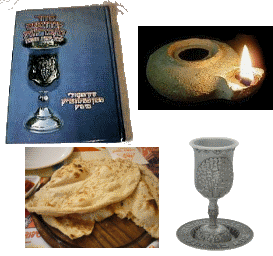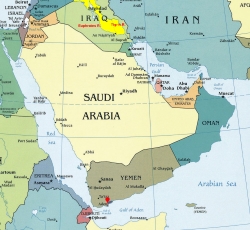bᵊ-Reish•itꞋ 7th Eve (ËrꞋëv Sha•bâtꞋ)
Ël•oh•imꞋ Finishes His Mᵊlâkh•âhꞋ in Six Cosmic Days
Cosmic Yom Shᵊviy•iꞋ (Seventhday): Sha•bâtꞋ

In six cosmic days — epochs or phases — the universe, our galaxy, our solar system and the earth were finished.
 |
| Sha•bâtꞋ collage |
By the seventh cosmic yom, Ël•oh•imꞋ finished His mᵊlâkh•âhꞋ that He did. At the seventh cosmic yom, He ceased from all of His mᵊlâkh•âhꞋ that He did. Then Ël•oh•imꞋ blessed the seventh cosmic yom, and made it qâ•doshꞋ because in it Ël•oh•imꞋ ceased from all of His mᵊlâkh•âhꞋ that He created to make.
This was the seventh cosmic ërꞋëv followed by cosmic morning: defining the seventh cosmic yom of our universe, our earth, our world, our civilization and the descendants of Avraham, the people who practice Ta•na"khꞋ — Yi•sᵊr•â•eilꞋ.
And this is why Yi•sᵊr•â•eilꞋ commemorates seventhday of the week as Sha•bâtꞋ (a cessation, stoppage) from our personal and individual mᵊlâkh•âhꞋ) to commemorate Ël•oh•imꞋ establishing Sha•bâtꞋ from His mᵊlâkh•âhꞋ.
After the story of how Ël•oh•imꞋ created the universe, Ël•oh•imꞋ became known as ä' is Ël•oh•imꞋ.
Where was Gan EiꞋdën?
From antiquity, 'ä (ha-Sheim) Ël•oh•imꞋ landscaped Gan EiꞋdën and attracted •dâmꞋ, whom He had evolved, there. And ä' Ël•oh•imꞋ caused to sprout from the a•dâm•âhꞋ every delightful plant — tree, shrub and bush — to see or eat.
Also within the gan, He included the pomegranate Genealogy-Tree of Life and the fig Morality Tree.
 |
A river went forth from Gan EiꞋdën, dispersing into four bodies of water (ancient rivers, according to tradition):
- Pish•onꞋ: the Red Sea, which bounds Ethiopia, a land having gold, incense and sardonyx gems;
- Gikh•onꞋ: the Gulf of EidꞋen, which encircles whole land of Yemen;
- the Tigris; and
- the Euphrates.
 |
| sardonyx (Yo•seiphꞋ) |
Thus, the "rivers" of Gan EiꞋdën seem to have extended from Mesopotamia (central Iraq) dispersing southeast into the Persian Gulf, southwest around the Gulf of Eiden, then northwest up the Red Sea — the Middle East.
Man developed over many eons; mutating and adapting to various regions as different bands dispersed from Africa throughout the Middle East, India, Asia and Europe. In Africa, where the sun is bright and hot, people mutated tall, thin and dark-skinned. In India, people also mutated tall and thin, but not quite as dark-skinned; while in Asia, people were shorter and light-skinned and in Europe people developed shorter, stockier and pale-skinned. In the Middle East area of Gan EiꞋdën, people developed mid-sized and bronze-skinned.
History Couldn't Be Recorded Until Man Learned To Write
Ancient cave pictographs document pre-Adamic (i.e. prehistoric) development of agrarian (garden-farming![]() ) cultures and animist and anthropomorphic (idolatrous) religious belief systems.
) cultures and animist and anthropomorphic (idolatrous) religious belief systems.
No one could record pre-Adamic (= pre-historic) human history until man developed language and, critically, learned to write things down. Writing first developed in the Middle East, around B.C.E. 3200, eons after the earliest human beings had mutated. The earliest extant written record of human history relates the earliest lore about those eons, which the first writers of history, the family of the Bible, had heard around their campfires – conjecturing how humans had come to be.
According to these earliest writings, at some earlier time ä' Ël•oh•imꞋ had created an •dâmꞋ and Khav•âhꞋ in a wonderful Gan EiꞋdën among the rivers of the Middle East and commanded •dâmꞋ: You may eat the fruit of every edible plant in the gan except the fig Morality Tree. But you must not eat of the fig Morality Tree because the day that you do, you then become different from the other animals — liable to capital punishment for whatever bad you then, by your free will, choose to do.
From the inception of •dâmꞋ, ä' Ël•oh•imꞋ had purposed that it wasn't good for •dâmꞋ to be alone. So He formed woman with a gene of •dâmꞋ to be a complementary mate — whom he named Khav•âhꞋ because she was the mother of a new kind of family regarded as fully and truly human beings. Though they were both naked, neither were ashamed.
Why are human beings the only animal to wear clothes? Are human beings the only animal with enough intelligence to make clothes to keep warm? Then why do we wear clothes even when it's hot?
 |
| Squamata (scaled reptile): Varanus salvator (water monitor; EncyIl Mondo degli Animali Rizzoli 1968) |
Now men — being bigger, stronger and faster — mostly hunted animals. Women gathered wild fruits and vegetables. And the nâ•khâshꞋ, because of its stare, was regarded as the most divining creature of the field.
One day as Khav•âhꞋ was gathering fruits in the gan, she encountered a nâ•khâshꞋ near the fig Morality Tree. The nâ•khâshꞋ raised up its head and stared at her. It seemed to be challenging her right to gather fruit in the gan. It seemed to be taunting her, "Didn't Ël•oh•imꞋ tell you not to eat the fruit of any of these trees, bushes, shrubs and plants?"
Actually, no, she thought. We're allowed to eat the fruit of "plants of the gan." It's just "the Plant within the gan" that we can't touch or eat or we'll die. "The plant" means one plant. So perhaps that means we can't eat or touch "the pomegranate Genealogy-Tree of Life" because, like humans, its seeds are internal; and it is the arils, surrounding each of the pomegranate's seeds, that are edible.
Since the pomegranate was regarded as the genealogical "Tree of Life," eating the pomegranate arils off of its seeds destroys the seeds of this Tree of Life — which, it was thought, might cause us to die!
So, if only "the pomegranate Genealogy-Tree of Life" is prohibited, then that would mean that it must be ok to eat the fruit of the other tree, the fig Morality Tree. They reasoned that eating a fig wouldn't destroy any fruit of "the pomegranate Genealogy-Tree of Life." So eating a fig wouldn't cause their seed to die within the woman. Instead, they reasoned, they would become sapient, like Ël•oh•imꞋ — moral.
The fruit of the fig Morality Tree looked delicious, the enormous tree looked grand and exquisite and she wanted to understand morality. So she tried it and it was edible and tasty so she brought it home to serve with dinner.
 |
When •dâmꞋ came home from the hunt and they had dinner, they each bit into a fig. When they saw the inside of the fig, its shape reminded them both of Khav•âhꞋ, giving them a new insight into morality. The inside of the fig had been covered and secret until they opened it to enjoy its fruit together. Then they realized that the fig seemed to be an example: concealing the inner shape of its fruit-offspring — the fig — with a covering of leaves.
That is when •dâmꞋ and Khav•âhꞋ had their Eureka moment: like the Morality Tree, they should conceal their inner shape — that produces human-offspring — with a covering made from the leaves of the Morality Tree.
So, they mimicked the fig Morality Tree: using vine, •dâmꞋ and Khav•âhꞋ each stitched two of the leaves of the Morality Tree together at their apex lobes to form a loin-covering brief, which they then tied together with vine on each side.
When dusk signaled the traditional prayer time beginning a new day, the evening ruꞋakh rustled through the trees of the gan. Hearing this qol ä' Ël•oh•imꞋ, they realized that their new fig-leaf loin-coverings were obvious and would be noticed by ä' Ël•oh•imꞋ. So they hid among the trees of the gan.
But they realized that humans cannot hide from ä' Ël•oh•imꞋ. The rustling of the trees seemed to be saying, "Where are you?"
"We are hiding because we're not supposed to know that our nakedness must be covered," they argued.
But the evening øåÌçÇ continued to rustle unceasingly in the trees, seemingly demanding an answer. "Who informed you that you were naked?" the rustling trees seemed to say. "Did you eat a fig of the Morality Tree that I commanded you not to eat?"
Then •dâmꞋ invented blame-shifting: "Khav•âhꞋ, whom you created to complement me, she brought home the fig and served it to me so I ate it."
Still, the evening øåÌçÇ continued to rustle unceasingly in the trees, now seeming to demand an answer from Khav•âhꞋ. "The nâ•khâshꞋ tricked me," she blame-shifted, "and I ate it."
According to tradition, the transgression by Khav•âhꞋ is why childbirth is painful for women and the transgression by •dâmꞋ is why people must work hard and compete for scarce resources in order to eat. The lizard's part in the transgression of •dâmꞋ and Khav•âhꞋ eating the fig of the Morality Tree is cited as why this particular species of scaled lizards [reptiles] evolved smaller and smaller legs — until their legs disappeared entirely: snakes [which are also reptiles], condemned to slither on their bellies.
So, in the Gan EiꞋdën of the Middle East, •dâmꞋ and Khav•âhꞋ distinguished themselves from the other people from the Kalahari and Europe; originating a new, distinct and different family. The family of •dâmꞋ and Khav•âhꞋ recognized ä' Ël•oh•imꞋ rather than solely the ël•oh•imꞋ, they adopted a new code of morality, and they began the first genealogical tree and oral record of their family — who would one day give birth to Avraham.
Today, we call the family genealogy-Tree of Life of •dâmꞋ and Khav•âhꞋ "recorded history". Before the Romans exiled us from Judea and destroyed this genealogy-Tree of Life, our family history was a public registry, the family Tree of Life in which all of our children were inscribed; girls at birth and boys after their Bᵊrit Mil•âhꞋ. This Tree of Life was called the yo•khas•inꞋ.
Yᵊsha•yahꞋu ha-Nâ•viꞋ noted that, just as ä' created light and differentiated it from darkness, He also placed His RuꞋakh in His servant, Yi•sᵊr•â•eilꞋ, more specifically, His chosen worker, the Mâ•shiꞋakh of Yi•sᵊr•â•eilꞋ in whom He placed His RuꞋakh — for the expressed purpose of bringing mi•shᵊpâtꞋ to the goy•imꞋ, but while preserving even the wounded Jew who has become like a bent reed ![]() or the flickering-out wick of an oil-lamp.
or the flickering-out wick of an oil-lamp. ![]()
Thus, ä' set Yi•sᵊr•â•eilꞋ and His Mâ•shiꞋakh to be a bᵊrit of the am and a light bringing mi•shᵊpâtꞋ-Tor•âhꞋ to the goy•imꞋ.

Optional parental preparation:
- Prepare and light a censer of incense before reading the story, preferably myrrh (even more authentic, if available, bdellium resin).
- If the child is old enough to eat a pomegranate safely, have a pomegranate and fig to serve during the day. Be sure to show the child how the fruits are opened, what they look like inside, to differentiate between the seed and the aril, and how to eat a pomegranate without swallowing a seed.
- Obtain 2 large fig leaves (or make 2 large paper fig leaves), some vine (or string) and scissors. So that you can demonstrate at bedtime, note how to join them with vine (or string) at the apex lobes to form a "leaf diaper," which can then be joined at the sides, also with vine (or string).
- If you have a sardonyx stone, have it handy to show. (Cameos are carved from sardonyx - flesh-colored banded chalcedony.) Raw (and even polished) sardonyx is quite cheap to obtain from an amateur stone collector. Worthwhile to show the child. Probably you have something gold you could show.
- A reed, once bent, is damaged and unstable. Unless splinted or propped up, even the slightest disturbance will cause it to fall over at the point where it was bent.
- Read my book about this Ha•phᵊtâr•âhꞋ: PishᵊtâhꞋ KheihâhꞋ Live-LinkT


Questions you might anticipate that your child might raise and be prepared to discuss:
- What is mᵊlâkh•âhꞋ?
- What does Sha•bâtꞋ mean? (cessation, stoppage)
- Review: what is the Ta•na"khꞋ
- Review: What is ä'? (the Name, é‑‑ä, too holy to utter or write in ordinary situations)
- What does qâ•doshꞋ mean? (holy — what does it mean? purified from transgressions against Tor•âhꞋ)
- How do you make a loin-covering with fig leaves?
Google+ registered author & publisher

